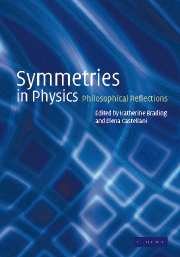Book contents
- Frontmatter
- Contents
- List of contributors
- Preface
- Copyright acknowledgements
- 1 Introduction
- Part I Continuous symmetries
- 2 Classic texts: extracts from Weyl and Wigner
- 3 On continuous symmetries and the foundations of modern physics
- 4 The philosophical roots of the gauge principle: Weyl and transcendental phenomenological idealism
- 5 Symmetries and Noether's theorems
- 6 General covariance, gauge theories, and the Kretschmann objection
- 7 The interpretation of gauge symmetry
- 8 Tracking down gauge: an ode to the constrained Hamiltonian formalism
- 9 Time-dependent symmetries: the link between gauge symmetries and indeterminism
- 10 A fourth way to the Aharonov–Bohm effect
- Part II Discrete symmetries
- Part III Symmetry breaking
- Part IV General interpretative issues
- Index
4 - The philosophical roots of the gauge principle: Weyl and transcendental phenomenological idealism
Published online by Cambridge University Press: 08 October 2009
- Frontmatter
- Contents
- List of contributors
- Preface
- Copyright acknowledgements
- 1 Introduction
- Part I Continuous symmetries
- 2 Classic texts: extracts from Weyl and Wigner
- 3 On continuous symmetries and the foundations of modern physics
- 4 The philosophical roots of the gauge principle: Weyl and transcendental phenomenological idealism
- 5 Symmetries and Noether's theorems
- 6 General covariance, gauge theories, and the Kretschmann objection
- 7 The interpretation of gauge symmetry
- 8 Tracking down gauge: an ode to the constrained Hamiltonian formalism
- 9 Time-dependent symmetries: the link between gauge symmetries and indeterminism
- 10 A fourth way to the Aharonov–Bohm effect
- Part II Discrete symmetries
- Part III Symmetry breaking
- Part IV General interpretative issues
- Index
Summary
As far as I see, all a priori statements in physics have their origin in symmetry.
(H. Weyl, 1952, p. 126)The most important lesson that we have learned in this century is that the secret of nature is symmetry.
(D. Gross, 1999, p. 57)Introduction
Most readers of this volume will know that the ancestry of gauge field theories extends back to Hermann Weyl's 1918 theory of ‘gravitation and electricity’. Since papers of Yang and others in the 1970s recovered this lineage from obscurity, considerable interest has been shown, and a few years ago a new English translation of Weyl's original paper appeared. The broad outline of the story is now common currency and need not be rehearsed in any detail here. Yet there are several largely unacknowledged aspects that arguably have more than incidental interest for those interested in philosophical issues of the significance of local symmetries. First of all, Weyl did not start out with the objective of unifying gravitation and electromagnetism, but sought to remedy a perceived blemish in Riemannian ‘infinitesimal’ geometry. The resulting ‘unification’ was, as it were, serendipitous. Then there is the not insignificant matter of Einstein's ‘pre-history’ objection, commonly affirmed to have sealed the unhappy fate of Weyl's theory. Just several weeks after hailing Weyl's theory as ‘a stroke of genius of the first magnitude’, Einstein reasoned that it was in blatant contradiction with the known constancy of the spectral lines of the chemical elements.
- Type
- Chapter
- Information
- Symmetries in PhysicsPhilosophical Reflections, pp. 61 - 88Publisher: Cambridge University PressPrint publication year: 2003
- 4
- Cited by

